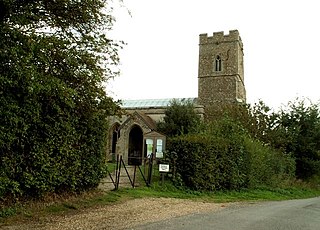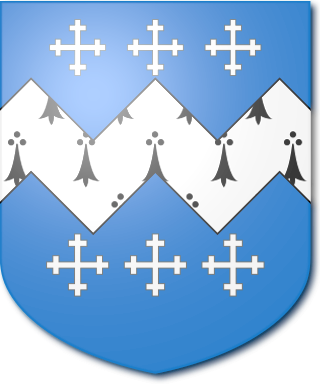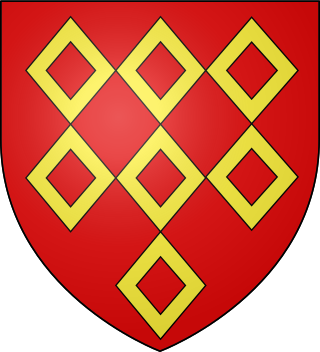Related Research Articles

Nicholas de Crioll, of a family seated in Kent, was Constable of Dover Castle and Keeper of the Coast during the early 1260s. His kinsman Bertram de Criol had distinguished himself in these offices during the preceding 20 years and both were near predecessors of the eminent Warden of the Cinque Ports, Stephen de Pencester.

Barnardiston is a village and parish in the West Suffolk district of Suffolk, England. The village is located about four miles north-east of Haverhill off the A143.

Great Coates is a village and civil parish in North East Lincolnshire, England. It is to the north-west and adjoins the Grimsby urban area, and is served by Great Coates railway station.

Freckenham is a small rural village and civil parish in the West Suffolk district of Suffolk in East Anglia, in the country of England.
The Blois family have been substantial landowners in Suffolk for several centuries. Until recently the family home was at Cockfield Hall in Yoxford, Suffolk, a Grade 1 listed private house standing in 40 acres (160,000 m2) of historic parkland.
John Sandale was a Gascon medieval Lord High Treasurer, Lord Chancellor and Bishop of Winchester.
Sir William Boleyn, KB of Blickling Hall in Norfolk and Hever Castle in Kent, was a wealthy and powerful landowner who served as Sheriff of Kent in 1489 and as Sheriff of Norfolk and Suffolk in 1500. He was the father of Thomas Boleyn, 1st Earl of Wiltshire, whose daughter was Queen Anne Boleyn, the second wife of King Henry VIII.

Butley Priory, sometimes called Butley Abbey, was a religious house of Canons regular in Butley, Suffolk, dedicated to The Blessed Virgin Mary. It was founded in 1171 by Ranulf de Glanville, Chief Justiciar to King Henry II (1180-1189), and was the sister foundation to Ranulf's house of White canons (Premonstratensians) at Leiston Abbey, a few miles to the north, founded c. 1183. Butley Priory was suppressed in 1538.
Campsey Priory,, was a religious house of Augustinian canonesses at Campsea Ashe, Suffolk, about 1.5 miles (2.5 km) south east of Wickham Market. It was founded shortly before 1195 on behalf of two of his sisters by Theobald de Valoines, who, with his wife Avice, had previously founded Hickling Priory in Norfolk for male canons in 1185. Both houses were suppressed in 1536.

Flixton Priory was a nunnery under a prioress following the Augustinian rule, which formerly stood in the parish of Flixton in the north of the English county of Suffolk, about 3 miles (4.8 km) south-west of Bungay. It was founded by Margery de Creke in 1258, and was dissolved in 1536–37. It was the poorest of the nunneries within the Diocese of Norwich. The site of the priory, which was enclosed by a moat, was at the present Abbey Farm, where little apart from the position in the landscape and a small section of standing wall remain to be seen. It was scheduled as an ancient monument in 1953. It is privately owned and is not open to the public. It is suggested that some parts of the masonry may have been re-used in St Peter's Hall at St Peter, South Elmham.

Sir Nathaniel Barnardiston of Kedington, alias Ketton, Suffolk was an English landowner, magistrate and senior representative of a long-established knightly family, one of the wealthiest in Suffolk, who sat in the House of Commons for Sudbury twice and for the Shire three times between 1625 and 1648.
Sir Thomas Barnardiston, 1st Baronet was an English baronet, landowner, soldier and MP who sat in the House of Commons at various times between 1640 and 1659. He fought on the Parliamentary side in the English Civil War.

Sir Edmund Walsingham of Scadbury Hall, Chislehurst in Kent, was a soldier, Member of Parliament, and Lieutenant of the Tower of London during the reign of King Henry VIII.

Sir Stephen Soame was an English merchant, landowner and politician who sat in the House of Commons in 1601. He served as Lord Mayor of London for the year 1598 to 1599.

There have been two baronetcies created for members of the Barnardiston family, both in the Baronetage of England. Both creations are extinct.

Sir Robert Brooke was an English landowner, magistrate, commissioner, administrator and MP who sat in the House of Commons between 1624 and 1629. He made his country seat at Cockfield Hall, Yoxford, Suffolk.
John Hopton was an English landowner and administrator with estates in Suffolk and Yorkshire who was active in local government during the reigns of King Henry VI and King Edward IV.

William Ferrers, 3rd Baron Ferrers of Groby (1333–1371) was a Leicestershire-based nobleman in fourteenth-century England who took part in some of the major campaigns of the first part of the Hundred Years' War. The eldest of two sons to Henry Ferrers, 2nd Baron Ferrers of Groby (d. 1343), and Isabel de Verdun, daughter of Theobald de Verdun, 2nd Baron Verdun, William was ten years old when he succeeded his father to the Barony.

Ipswich Greyfriars was a mediaeval monastic house of Friars Minor (Franciscans) founded during the 13th century in Ipswich, Suffolk. It was said conventionally to have been founded by Sir Robert Tibetot of Nettlestead, Suffolk, but the foundation is accepted to be set back before 1236. This makes it the earliest house of mendicant friars in Suffolk, and established no more than ten years after the death of St Francis himself. It was within the Cambridge Custody. It remained active until dissolved in the late 1530s.

Sir Edward Echyngham, , of Barsham and Ipswich in Suffolk, was a commander on land and at sea, briefly Constable of Limerick Castle, and Collector of Customs at Ipswich. He is remembered as the author of a letter to Cardinal Wolsey describing the death of Lord Admiral Howard at Brest in 1513. From 1485 the presence of the Howard Dukes of Norfolk was felt directly along the Barsham reach of the River Waveney from their possession of Bungay Castle.
References
- 1 2 3 John Burke; Sir Bernard Burke (1844). A Genealogical and Heraldic History of the Extinct and Dormant Baronetcies of England, Ireland, and Scotland. J. R. Smith. pp. 39–41. Retrieved 2013-10-25.
- ↑ R. Almack, 'Kedington alias Ketton and the Barnardiston family', Proceedings of the Suffolk Institute of Archaeology, IV Part 4 (1870), pp. 123-82 (Google).
- ↑ W. Rye, A Calendar of the Feet of Fines for Suffolk (W.E. Harrison, Ipswich 1900), Fines 6-7 Edward II, p. 128 no. 32, CP 25/1/217/54 no. 32 (View original at AALT image 0208).
- ↑ Margery and her son Thomas occur in Suffolk Fines of 8 Edward II: Rye, A Calendar of the Feet of Fines for Suffolk, p. 132 nos. 1 and 15 (Internet Archive): CP 25/1/217/56, 1 & 15 (View originals at AALT, image 0271 and image 0286).
- ↑ W.A. Copinger, The Manors of Suffolk : notes on their history and devolution, V: Risbridge Hundred (Taylor, Garnett, Evans, & Co., Ltd, Manchester 1909), Barnardiston, pp. 191-92
- ↑ W. Rye, A Calendar of the Feet of Fines for Suffolk, Fines 4-5 Edward II, no. 53, p. 123, CP 25/1/217/52 no. 53 (View original at AALT image 0114); 5 Edward II, no. 20, p. 125, CP 25/1/217/53 no. 20 (View original at AALT image 0139).
- ↑ Almack, 'Kedington alias Ketton and the Barnardiston family', p. 123 (Google).
- ↑ W.A. Copinger, The Manors of Suffolk : notes on their history and devolution, V: Risbridge Hundred (Taylor, Garnett, Evans, & Co., Ltd, Manchester 1909), Kedington pp. 255-61 (Internet Archive).
- 1 2 3 4 5 Kelly (1919). "Great Coates". Kelly's Directory of Lincolnshire. p. 141.
- ↑ G. Shaw, Old Grimsby (William Andrews & Co., London 1897), pp. 133-35 (Internet Archive).
- ↑ Historic England. "Church of St. Nicholas (1379843)". National Heritage List for England . Retrieved 24 August 2014.
- ↑ Almack, 'Kedington alias Ketton and the Barnardiston family', at p. 163 (Google).